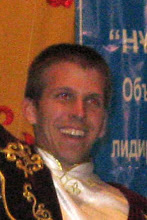This is my last guest blog post for "The Adventures of Hotard." It's a day late, but given that my final day in Kazakhstan also included a 32 hour travel period, I feel justified. I was flying over the Atlantic two weeks ago.
We finally arrived in Astana after a seemingly endless train adventure. I spent the evening and night sleeping with fish, wandering the train, hanging my head out the window, and smiling at people I couldn't understand. Michael slept like a baby.
When we reached Astana, Michael's Kazakh friend Berik was waiting to meet us. He graciously offered to spend the day with us and let us crash/store stuff at his place. He lived in a wonderfully quirky apartment in a very Soviet apartment building near the city center.
Immediately after dropping off our stuff, we visited a grocery store and then made breakfast. It was another chance for me to try disgusting traditional beverages of Kazakhstan. (The previous beverages experiences didn't make the blog, but they included fermented cow's milk and many cheap vodkas.) Up for taste test this morning was fermented horse milk and Kvas, neither of which I can really describe. Like all other traditional drinks in Kazakhstan, they are very sour.
We had a full day of sightseeing ahead of us, so we wasted little time. First on our list was the Palace of Peace and Reconciliation, which is a pyramid.
Before I continue, I must explain a bit about Astana and the history of Kazakhstan. Wikipedia explains this more thoroughly, but here goes. In the 19th century, Kazakhstan was inhabited by nomadic herders. Then the USSR happened and suddenly Russians and all kinds of other ethnic groups were being resettled by a centralized government that had a big agenda and little information about its newly incorporated territory. Because Kazakhs were nomads, there were very few cities and, to the USSR, the country looked empty. So they started resettling people there. Gradually, a largely "Soviet" culture developed in Kazakhstan, which was at conflict with the values of 19th century nomads.
Then, suddenly, in 1991, Kazakhstan became an independent country. They were independent for the first time since the turn of the century, and the world was very different now. That being said, Kazakh identity was very important for ethnic Kazakhs living in Kazakhstan. In part, this ethnic identity led to rifts between Kazakhs and Russians living in Kazakhstan. Since 1991, Kazakhstan has sought to distance itself from Russian culture and assert its own national identity. However, this identity is largely derived from a totally different place and time.
Astana is part of this redefinition of culture. Before becoming the capital in 1994, Astana was a tiny place in the vast northern steppe. Suddenly massive government investment was focused on creating a Kazakh city to serve as a center of national identity. Monuments were erected. Wildly bizarre architecture was commissioned. Buses with plasma TVs and strict schedules were instituted.
In the end, this new Kazakh culture succeeds in being "not Russian," but in many ways it is also "not Kazakh." Translating 19th century nomadic Kazakh culture into 21st century post-Soviet culture is a work in progress, and more art than science.
Back to Astana- and the Palace of Peace and Reconciliation. The building is full of symbolism, from the height to the number of floors to the colors of the walls to the stones used in the walkways. Doves are painted on the top floor. The first floor is the "underworld." The building holds periodic summits of all world religions, seeking to facilitate cross-cultural dialogue. Our tour guide acted like a robot- his mannerisms were incredible as he delivered various lessons in Kazakh history and the vision of President Nazarbayev for the monuments of Astana. The pyramid was a funny experience.
Then it was time for Bayterek, the most famous monument of Astana.
You'll notice a tower in the center of the picture with a golden egg on top. That's Bayterek. It's supposed to be a poplar tree. On top of Bayterek, there is a large golden egg (which you can visit via elevator - and I did). There is another monument with a golden bird on top. This golden bird laid this golden eggs.
I could go on and on about architecture and symbolism in Astana, but it's better if you experience it for yourself. The last 20 or so pictures in my Kazakhstan photo album capture just a small part of this identity-defining architecture prevalent throughout Astana.
The rest of the day, I kicked around the city with Michael and Berik. We later met up with Ken, another PCV, for dinner and dancing at this high-fashion restaurant called Fusion. Fusion cracked me up, mainly because it was part American steakhouse, part sushi bar, and 100% ridiculous Americana. There was a Harley-Davidson under spotlights by the hostess table and picture of George Washington on the wall.
It made for a wonderful final evening in Kazakhstan. Kazakh food, good music, old and new friends. There was a house singer who performed glorified karaoke all night with classic American tunes popular in Kazakhstan, which are few in number and not particularly popular in the US.
I left around 2am to head to the airport and begin my journey home. There is more to the story, but I'm actually traveling again right now and need to leave for the airport to begin my journey home once again, and so I must truncate my blog post. Please check out the photos, and stay tuned while we return to your regularly scheduled blogger.
-Brad Lindell






No comments:
Post a Comment